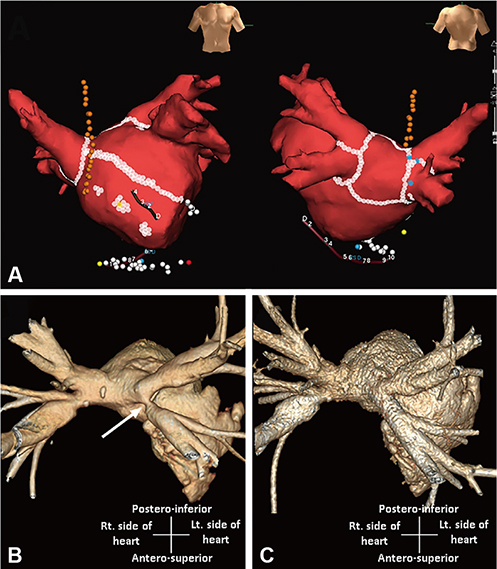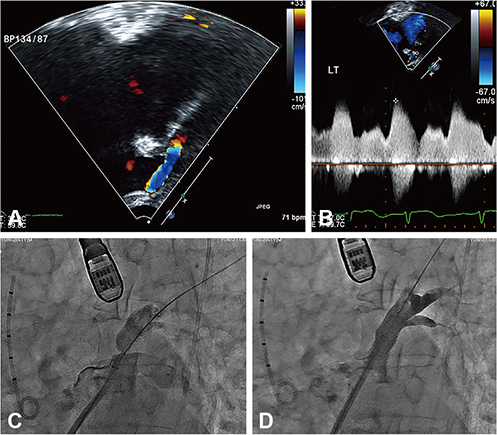Korean Circ J.
2017 Jul;47(4):528-531. 10.4070/kcj.2016.0382.
Controlled Atrial Fibrillation after Pulmonary Vein Stenting
- Affiliations
-
- 1Division of Cardiology, Department of Internal Medicine, Yonsei University College of Medicine, Seoul, Korea. hnpak@yuhs.ac
- KMID: 2392892
- DOI: http://doi.org/10.4070/kcj.2016.0382
Abstract
- When there is no pulmonary vein reconnection after catheter ablation for atrial fibrillation, patients can experience recurrence of atrial fibrillation without clear evidence of non-pulmonary vein foci. We describe a patient with significant pulmonary vein stenosis and recurrent atrial fibrillation after four ablation procedures. After successful pulmonary vein stenting, the symptoms were resolved, and sinus rhythm was maintained for 2 years without treatment with antiarrhythmic medication. We believe pulmonary vein stenting potentially controlled atrial fibrillation by providing pulmonary vein pressure relief or by compressing the epicardial triggers occurring at the pulmonary vein ostium.
MeSH Terms
Figure
Reference
-
1. Haïssaguerre M, Jaïs P, Shah DC, et al. Spontaneous initiation of atrial fibrillation by ectopic beats originating in the pulmonary veins. N Engl J Med. 1998; 339:659–666.2. January CT, Wann LS, Alpert JS, et al. 2014 AHA/ACC/HRS guideline for the management of patients with atrial fibrillation: a report of the American College of Cardiology/American Heart Association Task Force on Practice Guidelines and the Heart Rhythm Society. J Am Coll Cardiol. 2014; 64:e1–e76.3. Pak HN, Hwang C, Lim HE, Kim JS, Kim YH. Hybrid epicardial and endocardial ablation of persistent or permanent atrial fibrillation: a new approach for difficult cases. J Cardiovasc Electrophysiol. 2007; 18:917–923.4. Verheule S, Eckstein J, Linz D, et al. Role of endo-epicardial dissociation of electrical activity and transmural conduction in the development of persistent atrial fibrillation. Prog Biophys Mol Biol. 2014; 115:173–185.5. Chang SL, Chen YC, Chen YJ, et al. Mechanoelectrical feedback regulates the arrhythmogenic activity of pulmonary veins. Heart. 2007; 93:82–88.6. Calkins H, Kuck KH, Cappato R, et al. 2012 HRS/EHRA/ECAS expert consensus statement on catheter and surgical ablation of atrial fibrillation: recommendations for patient selection, procedural techniques, patient management and follow-up, definitions, endpoints, and research trial design: a report of the Heart Rhythm Society (HRS) Task Force on Catheter and Surgical Ablation of Atrial Fibrillation. Developed in partnership with the European Heart Rhythm Association (EHRA), a registered branch of the European Society of Cardiology (ESC) and the European Cardiac Arrhythmia Society (ECAS); and in collaboration with the American College of Cardiology (ACC), American Heart Association (AHA), the Asia Pacific Heart Rhythm Society (APHRS), and the Society of Thoracic Surgeons (STS). Endorsed by the governing bodies of the American College of Cardiology Foundation, the American Heart Association, the European Cardiac Arrhythmia Society, the European Heart Rhythm Association, the Society of Thoracic Surgeons, the Asia Pacific Heart Rhythm Society, and the Heart Rhythm Society. Heart Rhythm. 2012; 9:632–696.e21.7. Hsieh MH, Tai CT, Lee SH, et al. The different mechanisms between late and very late recurrences of atrial fibrillation in patients undergoing a repeated catheter ablation. J Cardiovasc Electrophysiol. 2006; 17:231–235.8. Montserrat S, Sitges M, Calvo N, et al. Effect of repeated radiofrequency catheter ablation on left atrial function for the treatment of atrial fibrillation. Am J Cardiol. 2011; 108:1741–1746.9. Hwang ES, Pak HN, Park SW, et al. Risks and benefits of an open irrigation tip catheter in intensive radiofrequency catheter ablation in patients with non-paroxysmal atrial fibrillation. Circ J. 2010; 74:644–649.
- Full Text Links
- Actions
-
Cited
- CITED
-
- Close
- Share
- Similar articles
-
- Role of non‑pulmonary vein triggers in persistent atrial fibrillation
- Percutaneous Pulmonary Vein Angioplasty for the Pulmonary Vein Stenosis After Catheter Ablation of Atrial Fibrillation
- Lobectomy due to Pulmonary Vein Occlusion after Radiofrequency Ablation for Atrial Fibrillation
- The Mechanism of and Preventive Therapy for Stroke in Patients with Atrial Fibrillation
- The Influence of Simplified Surgical Procedures on the Surgical Treatment for Atrial Fibrillation with using the Cut-and-Sew Technique




